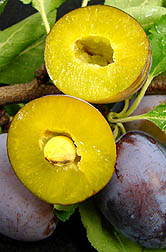This page has been archived and is being provided for reference purposes only. The page is no longer being updated, and therefore, links on the page may be invalid.
Read the magazine story to find out more. |
|
|
ARS Investigate Genes Involved in Forming Plum Pits
By Sharon DurhamApril 21, 2009
Agricultural Research Service (ARS) scientists are making progress in determining the genes that control pit formation in plums—the first step in a project to develop pitless varieties of this fruit.
ARS molecular biologists Chris Dardick and Ann Callahan and Prunus breeder Ralph Scorza at the ARS Appalachian Fruit Research Station in Kearneysville, W.Va., discovered that a set of genes necessary for production of lignin is rapidly turned on specifically in pit tissue—not the flesh or skin—just before hardening. Then these genes quiet down just as quickly after the stone hardens.
Lignin is a material involved in the formation of pits in stone fruit. Fruit pits consist of the seed and the hard woody material, or stone, surrounding the seed.
The researchers' goal is to establish techniques to stop the genes' activity and prevent hardening of the pit, thus producing a pitless plum that would be more appealing to consumers. Pitless fruit would be a premium product that could provide higher income for growers and could increase consumption of these nutritious foods.
The idea of pitless fruits is not new. In the early 1900s, Luther Burbank, a prolific horticulturalist, crossed a partially stoneless wild plum with California French prune varieties. These crosses led to commercial-quality fruit that almost completely lacked the stone, but still contained the seed. The group used samples of Burbank's crosses for their work.
The research team engineered Burbank's stoneless variety with an early-flowering trait that will greatly speed up the breeding program. The resulting fruit has remarkably little stone tissue, but further improvements are needed to make it edible, according to Dardick. Early flowering will substantially shorten the time it takes to test the strategies that may lead to pitless plums.
According to Dardick, if successful, the research may be applicable to other stone fruits, such as cherries, peaches, nectarines and apricots.
Read more about this research in the April 2009 issue of Agricultural Research magazine.
ARS is the principal intramural scientific research agency of the U.S. Department of Agriculture.

